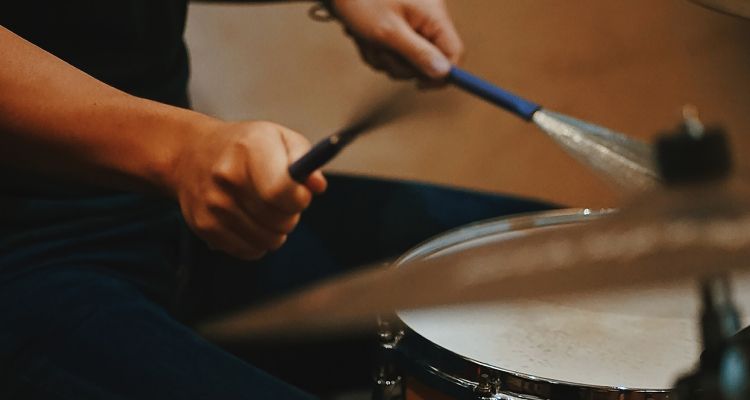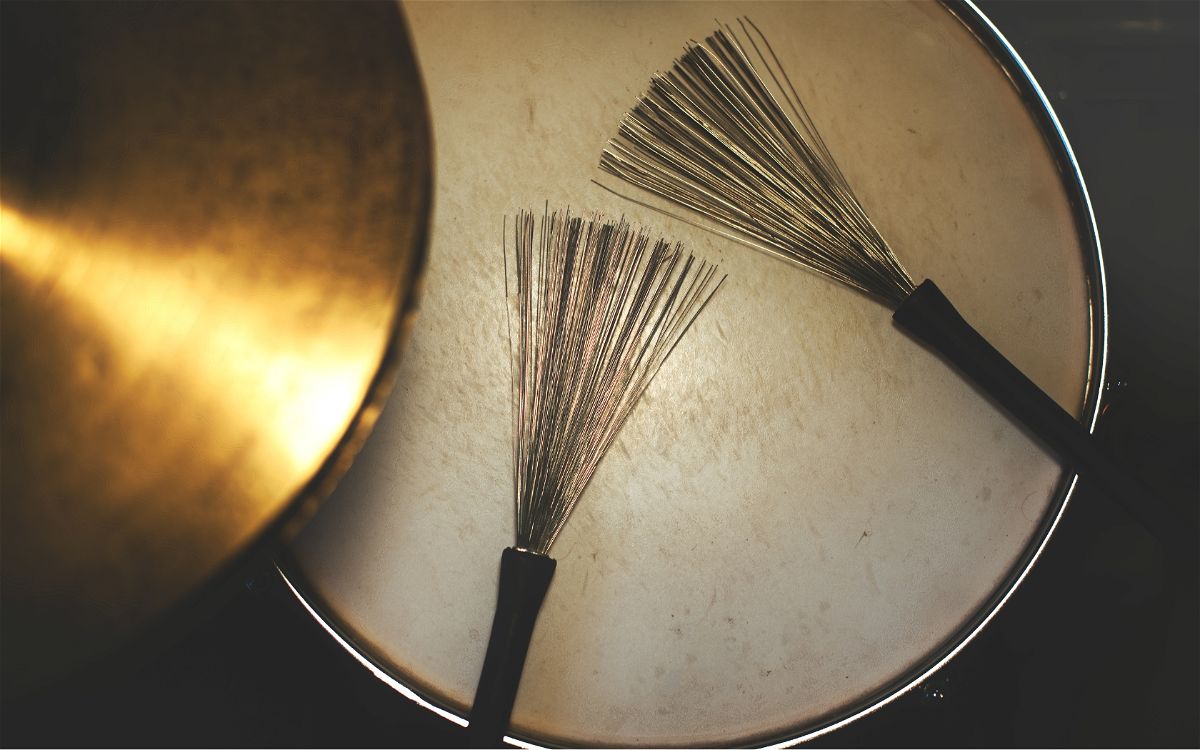Brushes are a common alternative to drumsticks, especially for jazz drummers. While you can simply use them to play the drums to get quieter sounds, there are more techniques to use that will produce unique tones that only brushes can offer.
I think they’re something that every drummer should own, so knowing how to use them is an important skill.
In this guide, I’m going to explain the main purpose of brushes. I’ll then break down how to use them most effectively.
Contents
What is the Purpose of Brushes?

Drum brushes serve several purposes. Firstly, jazz drum brushes offer a softer and more delicate touch compared to traditional drumsticks.
Brushes produce a lower volume compared to sticks, making them suitable for quieter, intimate jazz settings. They allow drummers to contribute to the rhythm without overpowering other instruments.
However, they don’t produce defined tones, so I don’t think they’re the answer to every soft song setting, especially when you want to hear distinct sounds from your cymbals. They’re just good when you want very light sounds from drums and cymbals.
The next purpose, and arguably the main reason why drummers use them, is that they produce unique brushing sounds when you scratch them across drumheads. The tonal sound of brushes is mostly used in jazz drumming.
Lastly, brushes are well-suited for creating a swinging and grooving feel in jazz music, and can be used to create subtle dynamics and nuances on the snare drum.
How to Hold Brushes
You can hold brushes the same way that you hold your regular drumsticks.
There are fewer mechanics to think about, as you can’t really find a fulcrum or balance point with the way brushes are designed. So, you don’t need to put much thought into it. Just do what feels most comfortable to you.
I know some drummers claim that using traditional grip makes it easier to do the sweeping motion on your snare drum, but I haven’t found that to be true.
I recommend just holding them with the same grip that you use when playing with regular sticks, which means matched grip is perfect.
Brush Drumming Techniques

Standard Playing
The first way to play brushes is just to play the drums in the same way that you would with normal sticks.
Instead of getting solid sounds with a lot of depth, you get lighter and thinner sounds from the skinny wires hitting the drumheads.
Just note that you don’t really hear much when playing the cymbals. You get a bit of wash, but that’s about it. This is especially true for the hi-hats. That’s why brushes are mainly used on drums.
You also get more volume when you strike the centers of all the drumheads.
Sweeping
Sweeping is what most drummers use brushes for. This is when you drag a brush across a drumhead to get a “shhh” sound. The longer your dragging motion, the longer the sound will be.
There are several techniques to get different sweeping sounds. One of the most basic ones for jazz drummers is to play a swing pattern on the snare.
Your right hand will play the same jazz swing pattern that you typically play on the ride cymbal. You’ll then sweep your left hand in a circular motion between beats one and two. On beat two, the sweep will stop to cut the sound.
You’ll then do the same thing between beats three and four.
This is just the beginning, though. As I said earlier, some jazz drummers go really deep into brush drumming techniques, and they’re able to play incredible things utilizing different sweeping methods.
Using the Retractable Wires
Most brushes have thicker wires on the end that you can pull to retract the thin wires into the handle.
These thicker wires typically have a curved design that allows you to stick your finger through to get a good grip. This design also makes it ideal to play cymbals with the brushes.
While the thin groups of wires don’t produce effective sounds from cymbals, you can turn the brushes around to strike the cymbals with the thicker metal.
You’ll get a very sharp sound that is a lot more effective. I just wouldn’t recommend doing this too often, as the metal on metal contact can be bad for your cymbals.
Using One Brush
If you really want to get good cymbal sounds while still having the ability to play sweeping patterns on the drums, you can hold a brush in one hand and a normal drumstick in the other.
This will also allow you to get louder sounds from the drums when you want to play accents.
You’ll regularly see jazz drummers doing this when they play. They’ll start with a pair of brushes at the beginning of a song. As things open up, they’ll use one drumstick to play ride cymbal patterns. They’ll then switch to using two drumsticks when things get really loud.
How to Make Brush Drumming Sound Good
The main thing you need to have when playing with brushes is coated drumheads. If you use clear drumheads, the brushes aren’t going to produce nice sounds when you do sweeping motions.
They only produce those great washing tones when rubbed against coated heads. This is the main reason why all jazz drummers use coated drumheads when they play.
You’ll also get more tone out of your drums when playing with single-ply coated drumheads and brushes. However, I’ve found two-ply coated heads to still work relatively well.
Should You Use Brushes in Styles Other Than Jazz Music?
Jazz is the main style where playing brushes works really well. A lot of people see brushes as a quieter alternative to sticks, so you’ll often hear them suggesting that you use brushes instead.
However, the fact that brushes sound quite weak on cymbals is a big reason to not use them for other styles.
If you’re playing a country gig in a bar or restaurant, it would be better to use something a bit thicker that sounds more refined on all the drums and cymbals. The go-to option there would be rute sticks.
So, brushes can be used for other styles, but they just work best for jazz.
Different Types of Brushes

Metal Wires
A standard set of brushes will have thin metal wires that bunch together when retracted and then spread out when you push them out of the handle.
Metal wires produce bright and snappy sounds on the drums, but the downside is that they can bend easily.
Plastic and Nylon Wires
Plastic and nylon wires produce lighter and warmer sounds than metal wires. A lot of drummers like these due to them being more durable.
While they can bend, they always pop back into place, whereas metal wires stay bent. They’re just not great if you want more volume from your drums.
Fixed and Retractable
Most pairs of brushes have retracting mechanisms. You pull the wires into the handle so that they’re protected when you don’t use them.
You get a few pairs that aren’t retractable, though. These ones are mostly plastic and nylon, so the wires don’t need to be as protected as metal wires.
Some non-retractable brushes have really thick wires, so they keep their shape no matter how you store them.
Conclusion
The concept of using brushes on the drums is quite simple, but the skill required to play intricate sweeping patterns is very high.
I’d mostly recommend learning how to use brushes if you want to play jazz, but there are plenty of times where they can be useful in other settings.
Start by learning basic sweeping patterns, and then you can learn a few more complicated techniques from there.
If you want to know which brushes are the best to buy, check out my in-depth guide on the best drum brushes.









